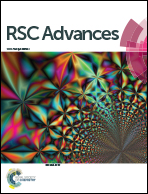MOF-derived Ni-based nanocomposites as robust catalysts for chemoselective hydrogenation of functionalized nitro compounds†
Abstract
Porous graphitic carbon layers encapsulating Ni nanoparticles (Ni@C) were prepared by a facile thermolysis of a Ni-containing metal–organic framework, the structure of which were characterized by power X-ray diffraction (XRD), N2 adsorption–desorption, transmission electron microscopy (TEM), and X-ray photoelectron spectroscopy (XPS) in detail. The resulting Ni@C nanocomposites served as highly efficient and magnetically recyclable catalysts for the hydrogenation of diverse functionalized nitro compounds to the corresponding anilines under relatively milder conditions. The high catalytic performance and the enhanced stability are ascribed to the synergistic effects and electron transfer between the metallic Ni and graphitic carbon as well as the unique encapsulation structure. The achieved success in the MOF-derived Ni@C nanocomposites may pave the way for designing environmentally benign catalytic hydrogenation processes for industrial applications.



 Please wait while we load your content...
Please wait while we load your content...